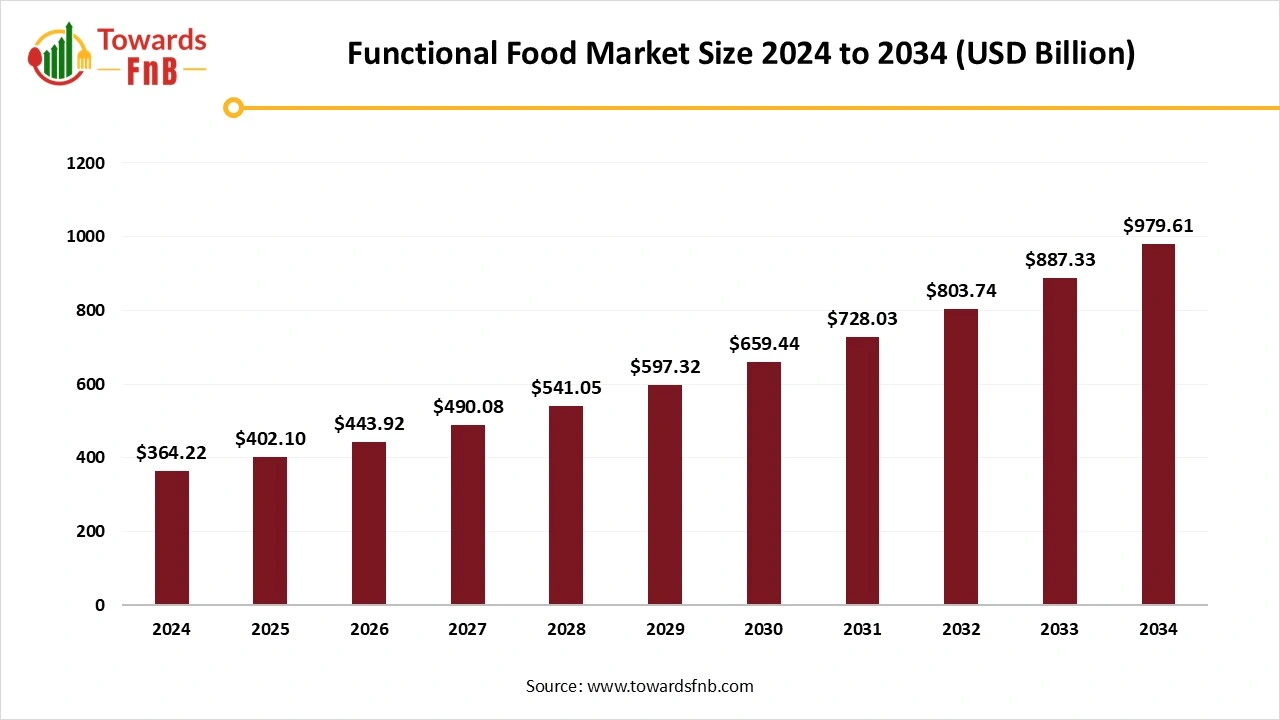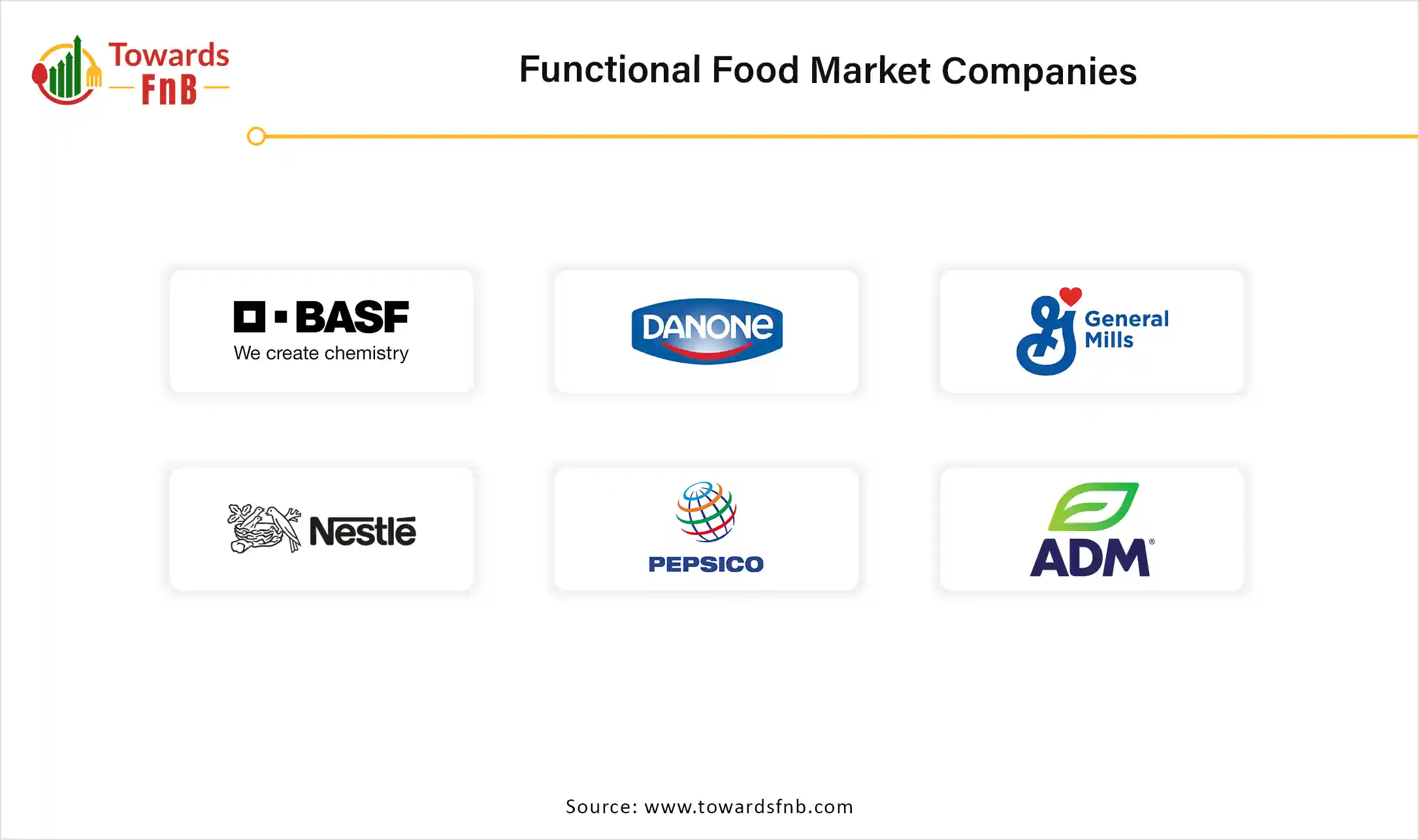December 2025
The global functional food market size estimated at USD 364.22 billion in 2024 and is anticipated to increase from USD 402.10 billion in 2025 to nearly reaching USD 979.61 billion by 2034, witnessing a CAGR of 10.4% during the forecast period from 2025 to 2034. Rising prevalence of the chronic disorders coupled with growing demand of the nutritional and fortified food driving the market.

| Study Coverage | Details |
| Growth Rate from 2025 to 2034 | CAGR of 10.4% |
| Market Size in 2025 | USD 402.10 Billion |
| Market Size in 2026 | USD 443.92 Billion |
| Market Size by 2034 | USD 979.61 Billion |
| Largest Market | Asia Pacific |
| Base Year | 2024 |
| Forecast Period | 2025 to 2034 |
| Regions Covered | North America, Europe, Asia-Pacific, Latin America, and Middle East & Africa |
In advanced economies, there is an increasing tendency toward healthier eating practices. This encourages consumers to develop new needs relative to the past, particularly the demand for high-quality items that offer various nutritional, advantageous, and functional attributes for their bodies due to which market is expanding. The wellness community, in general, has been embracing it quickly. The growth of the market is expected to be fueled by increasing disposable income and the resulting rise in expenditures on health and health-related food items. Moreover, the increase in cardiovascular ailments, obesity, and obesity-related disorders is expected to drive the global market in the upcoming period. For instance, functional foods comprise calcium-dense foods, omega-3 fatty acids, fiber, and various essential nutrients that assist in managing and lowering heart disease, hypertension and cholesterol.
Manufacturers of functional foods are introducing new flavors in the market to align with evolving consumer preferences. Furthermore, producers are concentrating on harmonizing the practical advantages and taste. Through advanced technology, producers have enabled the creation of products that disguise the unpleasant flavor of specific functional ingredients. Innovations in food technology and biotechnology, such as controlled release, encapsulation, and fermentation, have expanded the potential for creating these foods. Reflecting current market trends, the company creates tailored micronutrient blends that align with nutritional demands. Consumer interest in products that promote immunity, gut health, and cognitive function is increasing, leading to a rise in demand for innovative formulations.
A significant obstacle for functional foods is the absence of clear and uniform regulations in various countries and regions. Functional foods can be categorized as foods, dietary supplements, or drugs based on the market, with each category having distinct rules for labeling, claims, safety, and effectiveness. Additionally, the regulatory frameworks frequently evolve and shift, complicating the ability of functional food developers to remain aligned with the most recent standards and requirements. Consequently, developers of functional foods might encounter delays, expenses, or obstacles to entering certain markets.
Asia Pacific Dominated the Functional Foods Market in 2024.
A major reason driving this increase has been health issues related to lifestyle among individuals, such as obesity, diabetes, heart diseases, and hypertension cases. The World Health Organization states that more than 60% of the global population with diabetes lives in Asia, a shocking figure that underscores the growing health threats confronting the area. In nations such as China and India, where countless individuals are impacted by these ailments, the need for functional foods has soared. Historically, functional foods were marketed to developed regions like Japan and South Korea, as consumers in these nations were knowledgeable about wellness trends. It is expanding rapidly in emerging markets like China, India, and Southeast Asia, where personal health and wellness are viewed as very vital. Technological progress in the Asia Pacific has transformed food processing, facilitating the development of functional foods with enhanced nutritional values.
The India functional foods market is thriving, driven by an increase in health consciousness among people. Government bodies, NGOs, and businesses are actively involved in awareness initiatives, enhancing consumer knowledge of the health benefits linked to functional foods, consequently driving market expansion. Prominent food corporations such as Adani Wilmar, ITC, BigBasket, Tata Consumer, and Emami Agrotech are currently focusing on functional foods designed for health-oriented customers. These items, including low cholesterol ghee and low glycemic index foods, are offered at high prices.
North America Expects Significant Growth During the Forecast Period.
Functional foods in North America are experiencing substantial growth as more consumers lean towards healthier choices. Market growth is being fueled by product innovations in flavors and functional ingredients, as businesses aim to meet changing consumer preferences and tastes. The growing recognition of the health advantages linked to functional foods and drinks, particularly those abundant in omega-3, protein, and antioxidants, is driving higher demand. The primary application areas in the North American market include immunity, digestive wellness, weight control, and cardiovascular health.
The functional foods market in the United States, fueled by increasing consumer consciousness regarding health and wellness. The rising incidence of chronic illnesses and a movement toward preventive health have greatly increased the demand for functional foods. Another vital trend influencing the market is sustainability, as consumers look for clean-label products featuring natural, minimally processed components and ethical sourcing practices. The growth of e-commerce has additionally changed the industry, giving manufacturers chances to connect directly with consumers and offer a wider selection of niche products. Major global companies like General Mills, Nestlé, and Danone lead the market, utilizing their established presence to launch new products supported by scientific studies. In the United States, healthy food and beverages retail sales hit $320 billion across mass, convenience, and natural channels in 2024, with SPINS estimating they will exceed $384 billion by 2028.
Which Segment Dominated the Functional Foods Market in 2024?
Functional dairy products held the dominating share of the functional foods market in 2024. The rising focus on immunity, gut health, and overall wellbeing has boosted demand for fortified milk, probiotic yogurt, and functional cheese. Furthermore, the growth of the segment is influenced by technological advancement in dairy technology, the advancement of more sustainable dairy farming processes, and the ongoing change in consumer preferences toward healthier and more convenient food options.
Functional Fats and Oils Segment is Observed to Grow at the Fastest CAGR in the Functional Foods Market During the Forecast Period.
Rising interest in the functional fats and oils, such as oils fortified with antioxidants vitamins, and other bioactive compounds, is a significant trend fostering the expansion of the functional oils and fats, which comply with widespread rising interest by customers in health and wellness, are aiding to drive growth of the segment during forecast period. Functional oils contain nutraceutical components such as phytosterols, omega-3s, or antioxidants that offer specific health benefits, such as support for the heart, immune health or overall wellness.
Which Distribution Channel Held the Largest Share of the Functional Foods Market in 2024
Supermarkets/Hypermarkets segment held the largest share of the functional foods market in 2024. Supermarkets and hypermarkets provide a wide range of products, including different types functional foods, making it easier for customers to get these specialized items under single roof. Additionally, the big store size and strategic locations of supermarkets and hypermarkets captivate a large consumer base, permeating consumers to reach a wide audience, influencing the business of functional food. Furthermore, supermarkets and hypermarkets significantly prioritize health and wellness sections, advertising foods prominently to attract the health-conscious customer base. They invest in promotion and marketing strategies, developing awareness and driving consumer interest in functional foods.
Online Retail Segment is Seen to Grow at a Notable Rate During the Predicted Timeframe.
E-commerce is the quickest-expanding avenue, driven by the digital evolution of shopper habits and enhanced internet availability. E-commerce platforms provide convenience, an expanded variety, subscription choices, and tailored suggestions influenced by consumer behavior. For health-aware shoppers, the capability to effortlessly compare labels, access consumer reviews, and find high-quality or unique functional food brands is a notable benefit. Additionally, the impact of health promoters, fitness influencers, and dietitians endorsing functional foods on the internet is fueling a surge in direct-to-consumer sales.
Revo Foods
Synergy Flavours
Nutriearth

By Type
By Distribution Channel
By Region
December 2025
December 2025
December 2025
December 2025